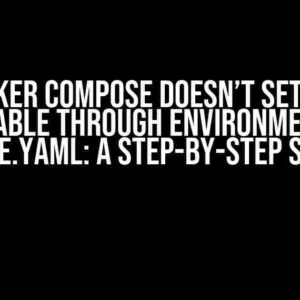Are you tired of manually running your Vue Playwright E2E tests every time you make a change to your code? Do you want to automate the testing process and ensure that your application is bug-free? Look no further! In this article, we’ll show you how to run Vue Playwright E2E tests in GitHub Actions, allowing you to focus on writing code while GitHub takes care of the testing.
- What are Vue Playwright E2E Tests?
- Prerequisites
- Step 1: Create a New GitHub Actions Workflow
- Step 2: Define the Workflow Triggers
- Step 3: Install Node.js and Dependencies
- Step 4: Run Playwright E2E Tests
- Step 5: Cache and Persist Data
- Step 6: Configure the Workflow
- Putting it all Together
- Conclusion
What are Vue Playwright E2E Tests?
Before we dive into the tutorial, let’s quickly cover what Vue Playwright E2E tests are. Vue Playwright is a popular testing framework for Vue.js applications that allows you to write end-to-end (E2E) tests for your application. E2E tests simulate real user interactions with your application, ensuring that it behaves as expected from start to finish.
Why Run E2E Tests in GitHub Actions?
Running E2E tests in GitHub Actions provides several benefits, including:
- Faster testing: GitHub Actions can run your tests in parallel, reducing the overall testing time.
- Automated testing: With GitHub Actions, you can automate the testing process, saving you time and effort.
- Improved code quality: By running E2E tests on every code change, you can catch bugs early on and ensure that your code is of high quality.
- Enhanced collaboration: GitHub Actions allows multiple team members to collaborate on testing, making it easier to identify and fix issues.
Prerequisites
Before we begin, make sure you have the following:
- A Vue.js application with Playwright E2E tests set up.
- A GitHub repository for your application.
- A basic understanding of GitHub Actions and YAML files.
Step 1: Create a New GitHub Actions Workflow
First, create a new file in your repository’s `.github/workflows` directory. Name it `e2e-tests.yml`. This file will contain the configuration for our GitHub Actions workflow.
mkdir .github/workflows touch .github/workflows/e2e-tests.yml
Step 2: Define the Workflow Triggers
In the `e2e-tests.yml` file, define the triggers for our workflow. We want to run the E2E tests on every push to the `main` branch. Add the following code:
name: E2E Tests
on:
push:
branches:
- main
Step 3: Install Node.js and Dependencies
Next, we need to install Node.js and our application’s dependencies. Add the following code:
jobs:
e2e-tests:
runs-on: ubuntu-latest
steps:
- name: Checkout code
uses: actions/checkout@v2
- name: Install Node.js
uses: actions/setup-node@v2
with:
node-version: '14'
- name: Install dependencies
run: npm install
Step 4: Run Playwright E2E Tests
Now, we can run our Playwright E2E tests using the following code:
- name: Run E2E tests
run: npx playwright test
This command runs the `playwright test` command, which executes our E2E tests.
Step 5: Cache and Persist Data
To speed up the testing process, we can cache and persist data using the following code:
- name: Cache and persist data
uses: actions/cache@v2
id: cache
key: $GITHUB_SHA-npm-
restore-keys: |
$GITHUB_SHA-npm-
npm-
- name: Persist data
uses: actions/upload-artifact@v2
if: always()
path: /home/runner/.npm/_cacache
This code caches and persists the `npm` cache, allowing us to reuse it in future runs.
Step 6: Configure the Workflow
Finally, let’s add some configuration options to our workflow:
- name: Configure workflow
env:
CI: true
PLAYWRIGHT_BROWSERS: chromium
This code sets the `CI` environment variable to `true` and configures Playwright to use the Chromium browser.
Putting it all Together
Here’s the complete `e2e-tests.yml` file:
name: E2E Tests
on:
push:
branches:
- main
jobs:
e2e-tests:
runs-on: ubuntu-latest
steps:
- name: Checkout code
uses: actions/checkout@v2
- name: Install Node.js
uses: actions/setup-node@v2
with:
node-version: '14'
- name: Install dependencies
run: npm install
- name: Cache and persist data
uses: actions/cache@v2
id: cache
key: $GITHUB_SHA-npm-
restore-keys: |
$GITHUB_SHA-npm-
npm-
- name: Run E2E tests
run: npx playwright test
- name: Persist data
uses: actions/upload-artifact@v2
if: always()
path: /home/runner/.npm/_cacache
- name: Configure workflow
env:
CI: true
PLAYWRIGHT_BROWSERS: chromium
Conclusion
That’s it! With this guide, you should now be able to run Vue Playwright E2E tests in GitHub Actions. By automating your testing process, you can ensure that your application is bug-free and of high quality.
| Benefits | Description |
|---|---|
| Faster testing | GitHub Actions can run your tests in parallel, reducing the overall testing time. |
| Automated testing | With GitHub Actions, you can automate the testing process, saving you time and effort. |
| Improved code quality | By running E2E tests on every code change, you can catch bugs early on and ensure that your code is of high quality. |
| Enhanced collaboration | GitHub Actions allows multiple team members to collaborate on testing, making it easier to identify and fix issues. |
By following this guide, you can take your Vue.js application to the next level by automating your E2E testing process. Happy testing!
Frequently Asked Question
Get answers to the most pressing questions about running Vue Playwright E2E tests in GitHub Actions!
How do I set up Vue Playwright E2E tests in GitHub Actions?
To set up Vue Playwright E2E tests in GitHub Actions, you’ll need to create a new workflow file in your repository’s `.github/workflows` directory. In this file, define a job that installs Node.js, installs your project’s dependencies, and runs your Playwright E2E tests using the `npx playwright test` command. Don’t forget to specify the correct environment variables and configure your test settings!
What’s the best way to handle browser authentication for my Vue Playwright E2E tests in GitHub Actions?
To handle browser authentication for your Vue Playwright E2E tests in GitHub Actions, you can use environment variables to pass in credentials or use a secret manager like GitHub Secrets to store sensitive information. You can also use Playwright’s built-in support for authentication by creating a `playwright.config.js` file that exports an authentication function. This way, you can reuse your authentication logic across different tests and environments!
How can I debug my Vue Playwright E2E tests when they fail in GitHub Actions?
When your Vue Playwright E2E tests fail in GitHub Actions, debugging can be a challenge. To make things easier, you can use Playwright’s built-in debugging tools, such as the `–debug` flag, to get more detailed information about the test failure. You can also use GitHub Actions’ built-in debugging features, like the `debug` keyword in your workflow file, to pause the job and inspect the environment. And, of course, don’t forget to check the test output and browser logs for clues!
Can I use Vue Playwright E2E tests in GitHub Actions with a self-hosted runner?
Yes, you can use Vue Playwright E2E tests in GitHub Actions with a self-hosted runner! To do this, you’ll need to install Playwright and Node.js on your self-hosted runner machine. Then, configure your GitHub Actions workflow file to use the self-hosted runner and specify the correct environment variables for your tests. This way, you can run your E2E tests on your own infrastructure and take advantage of the flexibility and control that comes with self-hosted runners.
How can I optimize the performance of my Vue Playwright E2E tests in GitHub Actions?
To optimize the performance of your Vue Playwright E2E tests in GitHub Actions, try using parallel testing, where you split your tests into smaller chunks and run them simultaneously. You can also use Playwright’s built-in support for retries and timeouts to reduce flakiness and improve test reliability. Additionally, consider using a fast and lightweight browser like Chromium or Firefox, and make sure to clean up any unnecessary resources after your tests finish running. Every little bit counts when it comes to speeding up your testing pipeline!


